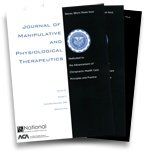Some doctors thrive in a personality-based clinic and have a loyal following no matter what services or equipment they offer, but for most chiropractic offices who are trying to grow and expand, new equipment purchases help us stay relevant and continue to service our client base in the best, most up-to-date manner possible. So, regarding equipment purchasing: should you lease, get a bank loan, or pay cash?
JMPT "White Papers" Provide Glimpse of Chiropractic Research, Today and Tomorrow
The final 2006 issue of the Journal of Manipulative and Physiological Therapeutics features a series of "white papers" co-authored by some of the most prominent researchers in the chiropractic profession. The papers provide insight into where the chiropractic profession is right now, particularly in terms of research, and where it may need to (or should) evolve to in the years ahead.

As Dynamic Chiropractic customarily reprints the abstracts from each issue of JMPT with the publication's permission, following a standard embargo period, we are pleased to do the same on this occasion.
JMPT Editor Claire Johnson, MSEd, DC, explains the value of the white papers in an editorial in the same issue:
"If one wanted to take the pulse of the current state of chiropractic, this issue of the JMPT would be a good place to start. The contents of this issue represents hundreds of hours of work. Literature searches, manuscript review, discussions, critique, all from some of the best minds in the chiropractic profession, have resulted in a snapshot of where some feel we are and where we need to go.
"These white papers, although not original experimental research themselves, provide a window into the soul of the chiropractic profession. They allow us to reflect on our past as well as help us to chart a course for future research. Compared with a similar set of white papers published approximately 10 years ago, one can see how the research focus has changed and [how] our course continues to evolve."
JMPT Abstracts for Nov/Dec 2006; Volume 29, Issue 9
Chiropractic clinical research: progress and recommendations.
Mitchell Haas, DC, MA; Gert Bronfort, DC, PhD; Roni L. Evans, DC, MS
Objective: The purpose of this white paper is to help inform the chiropractic clinical research agenda with a particularfocus on the United States.
Methods and Discussion: The recommendations and action items from two previous articles published in 1997 are discussed within the context of three broad topics: research culture, research infrastructure, and clinical research studies. Progress made toward the action items in these areas is summarized. A summary of findings is presented of the most influential clinical research studies during the past decade performed by or with major contributions by chiropractic investigators. In light of the current evidence and previous recommendations, new clinical research recommendations are proposed.
Conclusions: Based on the assessment of the scientific literature and research currently underway, it is evident that members of the chiropractic research community have made important progress in becoming active players in the clinical research arena. During the past decade, the work of chiropractic researchers has contributed substantially to the amount and quality of the evidence for or against spinal manipulation in the management of low back pain, neck pain, headache and other conditions.
Research in chiropractic education: an update.
John P. Mrozek, DC, Med; Hettie Till, MSc, MMedEd, DEd; Anne L. Taylor-Vaisey, MLS; David Wickes, DC
Purpose: The objectives of this review were to update the 1997 report on research in chiropractic education from the Research Agenda Conference in 1996 and to provide recommendations for the future direction of this research.
Methods: We conducted a review of the medical and chiropractic literature from March 1997 to March 2005 on the seven thematic areas identified in the Research Agenda Conference's 1997 article (i.e., curriculum, assessment, instructional methods, admissions, faculty development and evaluation, postgraduate and continuing education, and patient centeredness). We searched the following databases: MEDLINE, CINAHL, Alt HealthWatch, Index to Chiropractic Literature, MANTIS and ERIC. We hand-searched conference proceedings and relevant journals along with the reference lists of retrieved articles.
Discussion: Although research studies in chiropractic education have been conducted on the seven cited thematic areas, many have focused on instruction, curriculum, assessment, and faculty development. Research studies on areas recommended in the 1997 article, such as patient centeredness and continuing education, are less evident.
Conclusions: Researchers in chiropractic education need to focus their efforts on key areas of importance and interest. They should consider collaborating across the professions with individuals who share the same interest and who have a productive and successful research track record. Individual researchers should be willing to share and acknowledge the work of other colleagues in and across professions. One such area of research that meets these criteria and that is recommended for consideration is professionalism.
Health services research related to chiropractic: review and recommendations for research prioritization by the chiropractic profession.
Robert D. Mootz, DC; Daniel T. Hansen, DC; Alan Breen, DC, PhD; Lisa Z. Killinger, DC; Craig Nelson, DC
Purpose: This project updates a previous effort to inventory health services research conducted on chiropractic and makes recommendations for a subsequent research agenda. A qualitative review of social sciences, medical, chiropractic and health services research literature regarding chiropractic was done with emphasis on research published since the initial health services research agenda effort in 1995. This work informed development of updated health services research recommendations.
Methods: Literature was gathered through searches of electronic health care database retrieval systems and citation tracking. In addition to general collecting of new studies, the authors considered to what extent the 1995 research recommendations had been addressed in the new literature. A seed set of refined recommendations was formulated and initially distributed for expert review and revision. The recommendations were made available for public comment and hearing at the 10th Annual Research Agenda Conference for Chiropractic in March 2005.
Discussion: The past 10 years have seen numerous health service research studies related to chiropractic; however, nearly all of the research priorities identified in 1995 remain unaddressed and remain as important priorities. Thus, recommendations were reprioritized and revised to submit for open comment and hearing.
Conclusion: A smaller number of more concise recommendations with more specific action steps are proposed for clinical quality improvement, performing cost analyses and assessing use barriers for chiropractic.
Basic science research related to chiropractic spinal adjusting: the state of the art and recommendations revisited.
Gregory Cramer, DC, PhD; Brian Budgell, DC, PhD; Charles Henderson, DC, PhD; Partap Khalsa, DC, PhD; Joel Pickar, DC, PhD
Objective: The objectives of this white paper are to review and summarize the basic science literature relevant to spinal fixation (subluxation) and spinal adjusting procedures, and to make specific recommendations for future research.
Methods: PubMed, CINAHL, ICL, OSTMED, and MANTIS databases were searched by a multidisciplinary team for reports of basic science research (since 1995) related to spinal fixation (subluxation) and spinal adjusting (spinal manipulation). In addition, hand searches of the reference sections of studies judged to be important by the authors were also obtained. Each author used key words they determined to be most important to their field in designing their individual search strategy. Both animal and human studies were included in the literature searches, summaries, and recommendations for future research produced in this project.
Discussion: The following topic areas were identified: anatomy, biomechanics, somatic nervous system, animal models, immune system, and human studies related to the autonomic nervous system. A relevant summary of each topic area and specific recommendations for future research in each area were the primary objectives of this project.
Conclusions: The summaries of the literature for the six topic sections (anatomy, biomechanics, somatic nervous system, animal models, immune system, and human studies related to the autonomic nervous system) indicated that a significant body of basic science research evaluating chiropractic spinal adjusting has been completed and published since the 1997 basic science white paper. Much more basic science research in these fields needs to be accomplished, and the recommendations at the end of each topic section should help researchers, funding agencies, and other decision makers develop specific research priorities.
For information on how to access each paper in its entirety, visit www.mosby.com/jmpt.
JMPT Announces Call for Papers
With its January 2007 issue currently online, JMPT has issued a call for papers for its October issue, the contents of which will focus on "Poverty and Human Development." The theme issue is being organized in partnership with the Council of Science Editors, whose stated purpose is to "serve members in the scientific, scientific publishing, and information science communities by fostering networking, education, discussion, and exchange; and to be an authoritative resource on current and emerging issues in the communication of scientific information."
In October, JMPT and science journals around the world will publish original research, review articles, commentaries and other articles related to the topic of poverty and human development. As of press time, more than 140 journals from developed and developing countries have agreed to participate. (A complete list of participating journals is posted on the Council of Science Editors Web site - see link below.)
According to the council, this is the third effort to coordinate a theme issue among biomedical journals worldwide. In January 1996, an estimated 200 articles appeared in 36 journals from 21 countries, all devoted to the theme of "Emerging and Re-Emerging Global Microbial Threats." A year later, nearly 100 journals in 31 countries published simultaneously on the theme of "Ageing."
The deadline to submit a manuscript for potential inclusion in this special JMPT issue is April 30, 2007. For complete author instructions and other information, contact JMPT Editor Claire Johnson, MSEd, DC (cjohnson@nuhs.edu). To learn more about the Council of Science Editors and the global theme issue, visit www.councilscienceeditors.org/globalthemeissue.cfm.



